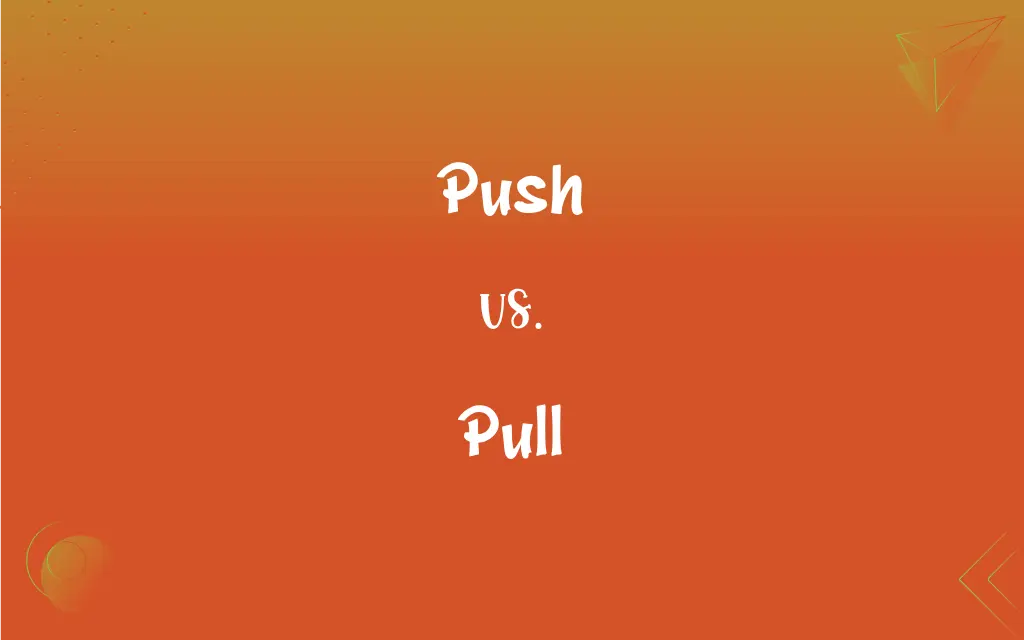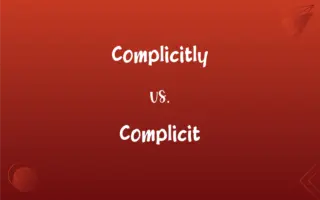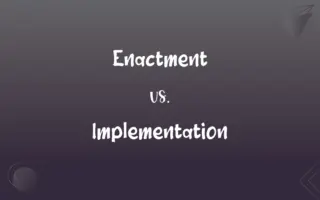Push vs. Pull: What's the Difference?
Edited by Janet White || By Harlon Moss || Updated on November 2, 2023
Push is applying force to move something away, while pull is exerting force to draw something towards oneself.

Key Differences
In physics, push is the force exerted on an object away from the source, whereas pull is the force drawing an object toward the source. Pushing and pulling are fundamental components of mechanics, reflecting opposite actions in relation to the point of force application.
When you push something, you impart force in a direction away from your body. Conversely, pulling something entails exerting force in a direction that brings the object closer to you. These actions are observed in everyday tasks, like pushing a door to open it, or pulling it to close.
The concept of push in marketing refers to a strategy where products are promoted to create customer demand, whereas pull strategy involves creating demand that encourages stores to stock a product. Here, push actively seeks to bring a product to the consumer, while pull aims to draw the consumer to the product.
In a user interface, a push action could be clicking a button to submit data, while a pull action might involve downloading information from a server. Push actions initiate interactions sending data out, while pull actions involve receiving or requesting information.
Push and pull can also metaphorically describe influences in a situation. A push factor might compel someone to leave a place, like a job, while a pull factor would be an attractant that draws them to another, like better opportunities elsewhere.
ADVERTISEMENT
Comparison Chart
Direction
Force applied away from the force source.
Force applied towards the force source.
Marketing Strategy
Products pushed onto consumers.
Consumers drawn to products.
User Interface
Sending data or commands outward.
Receiving or requesting data inward.
Force Type
Repulsive force away from the object.
Attractive force towards the object.
Example Usage
Pushing a shopping cart.
Pulling a rope.
ADVERTISEMENT
Push and Pull Definitions
Push
To compel or urge forcefully or persistently.
His coach continued to push him to improve his endurance.
Pull
To draw or attract someone or something.
The concert managed to pull a large crowd.
Push
To apply force on an object away from oneself.
She had to push the heavy door to open it.
Pull
To exert influence to cause a certain action.
The advertisement was designed to pull customers into the store.
Push
To cause to move in a forward direction.
He pushed the car until it started rolling down the hill.
Pull
To obtain or receive.
The star athlete managed to pull several major endorsements.
Push
To promote or advocate something actively.
The committee will push for stricter environmental regulations.
Pull
To apply force on an object towards oneself.
He had to pull the drawer open as it was stuck.
Push
To intensify effort or drive.
The team pushed hard in the final minutes to win the game.
Pull
To remove something from its place.
She had to pull the weeds out from the garden.
Push
To apply pressure against (something), especially for the purpose of moving it
Pushed the door but couldn't budge it.
Pull
To apply force to (something) so as to cause or tend to cause motion toward the source of the force
Pulled her chair up to the table.
Pulled the wagon down the street.
Push
To move (something) by exerting force against it; thrust or shove
Pushed the crate aside.
Pull
To remove from a fixed position; extract
The dentist pulled the tooth.
FAQs
What does 'pull' mean?
Pull involves exerting force on something to bring it closer to oneself or the source of force.
Can 'push' and 'pull' be used metaphorically?
Yes, both can describe intangible actions, like influencing a decision.
Are 'push' and 'pull' antonyms?
Yes, in the context of movement and direction, they are opposites.
Is 'pull' always a physical action?
No, it can also mean to attract or draw in a non-physical sense.
What is a 'push' notification?
It's a message that is sent to a user's device, prompting immediate attention.
What does 'push' mean?
Push refers to applying force to move something away from oneself or the source of force.
Is 'push' always physical?
No, 'push' can also refer to promoting ideas or agenda.
What does it mean to 'pull in' customers?
It means to attract customers into a business or service.
Can 'push' factors affect migration?
Yes, 'push' factors are conditions that drive people to leave their home area.
Can 'push' be used in marketing?
Yes, a push strategy means actively promoting products to consumers.
Can 'push' and 'pull' coexist in a scenario?
Yes, often both forces are at play, balancing each other out in various situations.
How does 'pull' relate to user interfaces?
'Pull' in UI involves actions that receive or request information.
How does 'push' relate to user interfaces?
In UI, 'push' actions initiate interactions like sending data.
How does 'push' work in physics?
It involves applying force to move an object away from the force source.
Can 'pull' be used in marketing?
Yes, a pull strategy creates consumer demand that encourages retailers to stock a product.
What is 'push-pull' strategy?
It's a combination of marketing strategies to push products onto consumers while also creating demand that pulls consumers to the product.
Can 'pull' factors affect migration?
Yes, 'pull' factors are conditions that attract people to a new area.
How does 'pull' work in physics?
It's the force drawing an object toward the source of force.
What does 'push back' mean?
It can mean to delay something or to resist against a force or idea.
What does 'pull together' mean?
It means to unite efforts towards a common goal.
About Author
Written by
Harlon MossHarlon is a seasoned quality moderator and accomplished content writer for Difference Wiki. An alumnus of the prestigious University of California, he earned his degree in Computer Science. Leveraging his academic background, Harlon brings a meticulous and informed perspective to his work, ensuring content accuracy and excellence.
Edited by
Janet WhiteJanet White has been an esteemed writer and blogger for Difference Wiki. Holding a Master's degree in Science and Medical Journalism from the prestigious Boston University, she has consistently demonstrated her expertise and passion for her field. When she's not immersed in her work, Janet relishes her time exercising, delving into a good book, and cherishing moments with friends and family.































































